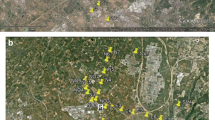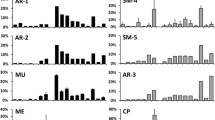Abstract
Substance Flow Analysis (SFA) is an important instrument that allows for the undertaking of environmental management for a specific contaminant. ‘Control Analysis’ is a tool that assesses the effect on a target flow of changes in flows forming part of a control basis set. The purpose of the present study was to perform a modeling of the annual PCDD/F flows in Tarragona Province and to apply the model for human health risk assessment. The validation of the model has been evaluated by comparing estimated fluxes with experimental values. Eleven subsystems, as well as a set of 88 flows of the system in Tarragona Province were considered. The total PCDD/F accumulation in Tarragona Province was between 62.6 and 159.5 g I-TEQ/y. Accumulation in sediments (27.9–74.6 g I-TEQ/y) and soils (35.0–80.8 g I-TEQ/y) are the two principal modes of deposition. Estimated flow in human adipose tissue means a mean intake of PCDD/F (via ingestion and inhalation) of 243 pg I-TEQ/person/day. The food chain pathway accounts for 99% of the total daily intake. As a result of the simulation, a 100% decrease in industrial emissions would cause a 1.7% reduction in the PCDD/F accumulation in humans. In turn, a 100% reduction of PCDD/Fs in the industrial waste waters would cause only an insignificant 0.1% decrease in the accumulation of PCDD/Fs in humans.
Similar content being viewed by others
References
Adriaens P, Fu Q, Grbic-Galic D (1995): Bioavailability and transformation of highly chlorinated dibenzo-p-dioxins and dibenzofurans in anaerobic soils and sediments. Environ Sci Technol 29: 2252–2260
Baker JL, Hites RA (2000): Is combustion the major source of polychlorinated dibenzo-p-dioxins and dibenzofurans to the environment? A mass balance investigation. Environ Sci Technol 34:2879–2886
Bauer G, Deistler M, Gleiss A, Glenck E, Matyus T (1997): Identification of material flow systems. ESPR — Environ Sci Pollut Res 4: 105–112
Boening DW (1998): Toxicity of 2,3,7,8-tetrachlorodibenzo-p-dioxin to several ecological receptor groups: a short review. Ecotoxicol Environ Safety 39: 155–163
Brzuzy LP, Hites RA (1995): Estimating the atmospheric deposition of polychlorinated dibenzo-p-dioxins and dibenzofurans from soils. Environ Sci Technol 29: 2090–2098
Brzuzy LP, Hites RA (1996): Global mass balance for polychlorinated dibenzo-p-dioxins and dibenzofurans. Environ Sci Technol 30: 1797–1804
De Fré R, Wevers M (1998): Underestimation in dioxin emission inventories. Organohalogen Compd 36: 17–20
Deistler M, Matyus T, Bauer G, Gleiss A, Glenck E, Lampert C (1998): Identification of material flow systems. Extensions and case study. ESPR — Environ Sci Pollut Res 5: 245–258
Dickson LC, Buzik SC (1993): Health risks of dioxins: a review of environmental and toxicological considerations. Vet Hum Toxicol 35: 68–77
Domingo JL, Schuhmacher M, Granero S, Llobet JM (1999): PCDDs and PCDFs in food samples from Catalonia, Spain. An assessment of dietary intake. Chemosphere 38: 3517–3528
Eduljee GH, Gair AJ (1996): Validation of a methodology for modelling PCDD and PCDF intake via the food chain. Sci Total Environ 187: 211–229
Fiedler H, Hutzinger O, Timms C (1990): Dioxins: sources of environmental load and human exposure. Toxicol Environ Chem 29: 157–234
Fiedler H (1996): Sources of PCDD/F and impact on the environment. Chemosphere 32: 55–64
Fuster G, Schuhmacher M, Domingo JL (2001): Flow Analysis of PCDD/Fs for Tarragona Province, Spain. A Preliminary Inventory. ESPR — Environ Sci Pollut Res 8: 91–94
IARC (International Agency for Research on Cancer) (1997): Polychlorinated dibenzo-p-dioxins and polychlorinated dibenzofurans: Summary of Data Reported and Evaluation. IARC Monographs 69, IARC Press, Lyon
Kogevinas M (2001): Human health effects of dioxins: cancer, reproductive and endocrine system effects. Hum Reprod Update 7:331–339
McLachlan MS (1995): Accumulation of PCDD/Fs in an agricultural food chain. Organohalogen Compd 26:105–108
Miller GC, Herbert VR, Miller MJ, Mitzel R, Zepp, RG (1989): Photolysis of octachlorodibenzo-p-dioxin on soil. Chemosphere 18:1265–1274
Pohjanvirta R, Tuomisto J (1994): Short-term toxicity of 2,3,7,8-tetrachlorodibenzo-p-dioxin in laboratory animals: effects, mechanisms and animal models. Pharmacol Rev 46: 483–549
Rieder M (1990): Estimating partitioning and transport of organic chemicals in the foliage/atmosphere system: Discussion of a fugacity model. Environ Sci Technol 24: 747–754
Schuhmacher M, Granero S, Llobet JM, De Kok HAM, Domingo JL (1997a): Assessment of baseline levels of PCDD/F in soils in the neighbourhood of a new hazardous waste incinerator in Catalonia, Spain. Chemosphere 35: 1947–1958
Schuhmacher M, Xifró A, Llobet JM, De Kok HAM, Domingo JL (1997b): PCDD/Fs in soil samples collected in the vicinity of a municipal solid waste incinerator: Human health risks. Arch Environ Contam Toxicol 33: 239–246
Schuhmacher M, Domingo JL, Llobet JM, Müller L, Sünderhauf WW, Jager J (1998): Baseline levels of PCDD/F in vegetation samples collected in the vicinity of a new hazardous waste incinerator in Catalonia, Spain. Chemosphere 36: 2581–2591
Schuhmacher M, Domingo JL, Llobet JM, Lindström G, Wingfors H (1999): Dioxin and dibenzofuran concentrations in adipose tissue of a general population from Tarragona, Spain. Chemosphere 38: 2475–2487
Tolosa I, Bayona JM, Albaigés J (1995): Spatial and temporal distribution, fluxes and budgets of organochlorinated compounds in Northwest Mediterranean sediments. Environ Sci Technol 29: 2519–2527
Thomas VM, Spiro TG (1996): The US Dioxin Inventory: are there missing sources? Environ Sci Technol 30: 820–850
Tysklind M, Fängmark I, Marklund S, Lindskog A, Thaning L, Rappe C (1993): Atmospheric transport and transformation of polychlorinated dibenzo-p-dioxins and dibenzofurans. Environ Sci Technol 27: 2190–2197
US EPA (1999): Economic Analysis of Effluent Limitations Guidelines and Standards for the Centralized Waste Treatment Industry, http://www.epa.gov/ostwater/guide/cwt/ewteae.html
UK Environmental Agency (1997): A review of Dioxin Releases to Land and Water in the UK, Research & Development Publication 3
WHO (World Health Organization) (1998): WHO experts re-evaluate health risks from dioxins. Press Release WHO/45
Author information
Authors and Affiliations
Corresponding author
Rights and permissions
About this article
Cite this article
Fuster, G., Schuhmacher, M. & Domingo, J.L. Human exposure to dioxins and furans. Environ Sci & Pollut Res 9, 241–249 (2002). https://doi.org/10.1007/BF02987498
Received:
Accepted:
Issue Date:
DOI: https://doi.org/10.1007/BF02987498




